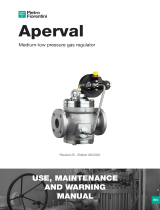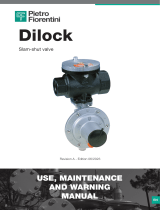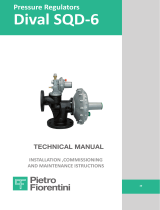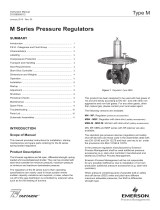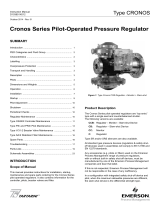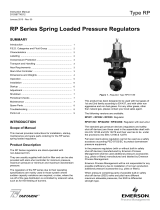
HEADQUARTERS Pietro Fiorentini S.pA. via E. Fermi 8/10 36057 Arcugnano (VI) ITALY US REPRESENTATIVE Pietro Fiorentini USA, Inc. 606 Park Drive Weirton, WV 26062 sales@fiorentini.comwww.fiorentini.comITALY +39 0444 968 511 USA +1 304 232 9115
1.1 - GENERAL SAFETY WARNINGS
The equipment described in this manual is:
• a device subject to pressure in pressurized systems;
• normally included in systems transporting flammable gases (for example: natural gas).
If the gas used is a combustible gas, the area where the equipment is installed is called a “danger zone” because
there are residual risks of the formation of potentially explosive atmospheres.
In and around “danger zones” it is absolutely:
• necessary there are no effective ignition sources present;
• prohibited to smoke.
Authorized operators shall not perform operations or interventions on their own initiative that are not within their
competence.
Never work on the equipment:
• Under the influence of exciting substances such as, for example, alcohol;
• In the case of using drugs that can lengthen reaction time.
The employer must train and inform operators on how to behave during operations and what equipment to use.
Before installation, commissioning or maintenance, operators must:
• Take note of the safety regulations applicable to the installation site where they are to operate;
• Obtain, when required, the necessary authorizations to operate;
• Equip themselves with the necessary individual safeguards required in the procedures described in this manual;
• Ensure that the area in which they are to work is equipped with the required collective protections and necessary safety signs.
1.2 - GENERAL INFORMATION ABOUT CONNECTIONS
The equipment must be installed in the line with the arrow on the body facing in the direction of gas ow. The on-line installation must include:
Pos. Description
1no.1 shut-off valve upstream of the equipment.
2no. 2 vent valves placed one upstream and one downstream of the equipment.
3no. 2 pressure gauges placed one upstream and one downstream of the equipment.
4no. 1 pressure regulator.
5no. 1 shut-off valve downstream of the equipment.
Fig. 1.1. In-line Installation Fig. 1.2. Square installation
When the device is used in gas pressure reduction stations, it must be installed at least according to the require-
ments of UNI EN 12186:2014 or UNI EN 12279:2007.
The vents of the equipment must be channeled according to UNI EN 12186: 2014 or UNI EN 12279: 2007 or the
standards in force at the place of installation of the equipment.
All the equipments used in the commissioning procedures are shown in chapter 1.11.
1.3 - CIRVAL INSTALLATION PROCEDURES
Step Operation
1Place the equipment in the section of the line used for it.
2Place gaskets between the line anges and the regulator anges.
3Insert the bolts into the appropriate holes in the connecting anges.
4Screw the bolts following the technical rules for tightening the anges.
For installation carried out after maintenance, replace the gaskets.
1.4 - REGULATOR COMMISSIONING PROCEDURE
In the application consisting of multiple parallel pressure control lines, it is recommended to commission one line at a time starting with the one with the
lowest set-point. The set-point value is recalled on the test certicate attached to each piece of equipment.
Step Operation
1Partially open the vent valve.
2
Very slowly open the upstream shut-off valve.
Check the pressure by referring to the pressure gauge located upstream.
3Check the pressure of the line inlet pipe by referring to the upstream pressure gauge.
4
To adjust the regulator to the required set-point value, remove the spring cap and turn the adjustment nut:
• clockwise to increase the pressure value;
• counterclockwise to decrease the pressure value.
Check the pressure by referring to the pressure gauge located downstream.
5Place and secure the spring cap.
6Close the vent valve.
7Check that the downstream pressure and make sure the regulator locks up and the pressure does not build.
8Check with a foaming substance the tightness of all joints located between the shut-off valves.
9
Very slowly open the downstream shut-off valve until the pipeline is completely lled.
• If the pressure of the downstream pipeline is lower than the set-point pressure, partialize the
opening of the downstream shut-off valve so as not to exceed the value of the maximum flow
rate of the system.
• Check the pressure by referring to the downstream pressure gauge.
1.5 - COMMISSIONING OF THE CIRVAL + IN LINE MONITOR OPERATION
Step Operation
1Remove the spring cap from the main regulator.
2Remove the spring cap from the regulator in inline monitor function.
3Partially open the vent valve.
4Very slowly open the upstream shut-off valve, checking that the downstream pressure (Pd) indicated by the downstream pressure gauge
(5) does not exceed the required setting value by more than 50%.
5Check the pressure of the line inlet pipe by referring to the upstream pressure gauge.
6Insert and tighten the Q key (chapter 1.11) in the slot of the cap to fully open the main regulator.
7
To adjust the in-line monitor regulator to the required set-point value turn the adjustment nut:
• clockwise to increase the pressure value;
• counterclockwise to decrease the pressure value.
Check the pressure by referring to the pressure gauge located downstream.
8Close the vent valve.
9Check that the downstream pressureand make sure the regulator locks up and the pressure does not build.
10 Partially open the vent valve.
11 Unscrew and remove the Q key (chapter 1.11) from the slot of the cap.
12 Check that the set-point pressure of the main regulator is at the set value by referring to the pressure value indicated by the downstream
pressure gauge.
13
Verify that the regulator with inline monitor function is fully open (100%).
The monitor regulator is fully open, when the pressure indicated on the intermediate pressure
gauge is the same as the upstream pressure gauge.
14 Close the vent valve.
15 Check that the downstream pressureand make sure the regulator locks up and the pressure does not build (refer to the nameplate SG
value).
16 Install and tighten spring cap on the main regulator.
17 Install and tighten spring cap on the in-line monitor regulator.
18 Check with a foaming substance the tightness of all joints located between the shut-off valves.
Step Operation
19
Slowly open downstream shut-off valve until the pipeline is completely lled.
• If the pressure of the downstream pipeline is lower than the regulator set point pressure,
partially open the downstream shut-off valve so as not to exceed the value of the maximum
flow rate and pressure of the system.
• Check the pressure by referring to the downstream pressure gauge.
1.6 - COMMISSIONING OF THE REGULATOR + IFM BUILT-IN MONITOR
In the application consisting of multiple parallel pressure control lines, it is recommended to commission one line at a time starting with the one with the
lowest set-point. The set-point value is recalled on the test certicate attached to each piece of equipment.
Step Operation
1Remove the spring cap from the main regulator.
2Remove the spring cap from the built-in IFM monitor.
3Partially open the vent valve.
4Very slowly open the upstream shut-off valve, checking that the downstream pressure (Pd) indicated by the downstream pressure gauge
does not exceed the required setting value by more than 50%.
5Check the pressure of the line inlet pipe by referring to the upstream pressure gauge.
6Insert and tighten the Q key (chapter 1.11) in the slot of the cap to fully open the main regulator.
7
To adjust the set point of the built-in IFM monitor turn the adjustment nut:
• clockwise to increase the pressure value;
• counterclockwise to decrease the pressure value.
Check the pressure by referring to the pressure gauge located downstream.
8Close the vent valve.
9Check that the downstream pressure and make sure the regulator locks up and the pressure does not build.
10 Partially open the vent valve.
11 Unscrew and remove the Q key (chapter 1.11) from the slot of the cap.
12 Check that the set-point pressure of the main regulator is at the preset value by referring to the pressure value indicated by the downstream
pressure gauge.
13 Close the vent valve.
14 Check that the downstream pressure (Pd), after an increment phase, does not exceed the closing pressure value of the main regulator (refer
to the nameplate SG value).
15 Insert the spring cap into the main regulator.
16 Insert the spring cap into the built-in IFM monitor.
17 Check with a leak foaming substance the tightness of all joints located between the shut-off valves.
18
Slowly open downstream shut-off valve until the pipeline is completely lled.
• If the pressure of the downstream pipeline is lower than the set-point, partially open the
downstream shut-off valve so as not to exceed the set-point of the maximum flow rate of the
system.
• Check the pressure by referring to the downstream pressure gauge.
1.7 - COMMISSIONING OF THE REGULATOR + IMD BUILT-IN MONITOR
In the application consisting of several pressure control lines, it is recommended to commission one line at a time starting with the one with the lowest
set-point. The set-point value is recalled on the test certicate attached to each piece of equipment.
Step Operation
1Remove the spring cap from the main regulator.
2Partially open the vent valve.
3Very slowly open the upstream shut-off valve, checking that the downstream pressure (Pd) indicated by the downstream pressure gauge
does not exceed the required setting value by more than 50%.
4Check the pressure of the line inlet pipe by referring to the upstream pressure gauge.
5Insert and tighten the Q key (chapter 1.11) in the slot of the cap to fully open the main regulator.
6Check the set-point value of the built-in IMD monitor by referring to the downstream pressure gauge.
7
Check the controlled escape of gas from the vent valve.
Check with foaming solution.
8Close the vent valve.
9Check that the downstream pressure and make sure the regulator locks up and the pressure does not build.
10
Check the controlled escape of gas from the vent.
Check with foaming solution.
11 Partially open the vent valve.
12 Unscrew and remove the Q key (chapter 1.11) from the slot of the cap.
This document is a guide for the installation and commissioning of Cirval regulator. It is compulsory to read the
complete operation, maintenance and warning manual before working on the device.
Full operation, maintenance and warning manual can be found on the PIETRO FIORENTINI S.P.A. website.
Cirval
Installation and
commisioning guide

HEADQUARTERS Pietro Fiorentini S.pA. via E. Fermi 8/10 36057 Arcugnano (VI) ITALY US REPRESENTATIVE Pietro Fiorentini USA, Inc. 606 Park Drive Weirton, WV 26062 sales@fiorentini.comwww.fiorentini.comITALY +39 0444 968 511 USA +1 304 232 9115
Step Operation
13
Check that the set-point pressure of the main regulator is at the preset value by referring to the pressure value indicated by the downstream
pressure gauge.
To adjust the regulator to the required set-point value turn the adjustment nut:
• clockwise to increase the pressure value;
• counterclockwise to decrease the pressure value.
14 Close the vent valve.
15
Check that there is no gas leakage from the vent.
Check with foaming solution.
16 Check that the downstream pressureand make sure the regulator locks up and the pressure does not build.
17 Check with a leak foaming substance the tightness of all joints located between the shut-off valves.
18
Slowly open downstream shut-off valve until the pipeline is completely lled.
• If the pressure of the downstream pipeline is lower than the set-point pressure, partially open
the downstream shut-off valve so as not to exceed the set-point and the maximum flow rate
of the system.
• Check the pressure by referring to the downstream pressure gauge.
1.8 - COMMISSIONING OF THE CIRVAL REGULATOR + LA SLAM-SHUT VALVE
1.8.1 - CHECK FOR LEAKAGE OF THE LA SLAM-SHUT VALVE
Step Operation
1Check that the slam-shut valve is in the closed position.
2Open the vent valve to completely drain the downstream section.
3Slowly open the upstream shut-off valve.
4
Check for leakage of the slam-shut valve through the vent valve.
Check the vent for leaks with a foaming substance.
1.8.2 - COMMISSIONING OF CIRVAL REGULATOR + LA SLAM-SHUT VALVE
Step Operation
1Check that the vent valve is partially open.
2Check that the LA slam-shut valve is in the closed position.
3Partially open the upstream shut-off valve, checking the pressure value indicated by the upstream pressure gauge.
4Perform the internal leakage test of the LA slam-shut valve, referring to Chapter 1.8.2.
5Slowly pressurize the downstream line by resetting the knob counterclowise to losen the LA slam-shut valve, checking that the downstream
pressure (Pd) indicated by the downstream pressure gauge does not exceed the required set-point value by more than 50%.
6
At the time the regulator goes into service, the pressure of the downstream pressure gauge will be equal to the set-point of the main
regulator.
In the first pressurization phase of the line, the pressure of the downstream pressure gauge may
exceed the required set-point value, depending on the response time of the regulator.
7Fully open the upstream shut-off valve.
8Check the pressure switch settings of the LA slam-shut valve by referring to Section 1.8.3.
9
If the downstream pressure (Pd) is not at the required set-point value, adjust the regulator as follows:
• value of downstream pressure (Pd) less than the required set-point value: screw the set-point spring by turning the spring adjustment
ring nut clockwise;
• value of downstream pressure (Pd) higher than the required set-point value: unscrew the set-point spring by turning the spring
adjustment ring nut counterclockwise.
10 Check the downstream pressure (Pd) by referring to the downstream pressure gauge.
11 Close the vent valve.
12
Check that the downstream pressure (Pd), after an increment phase, does not exceed the lock-up pressure value.
If the pressure in the section of pipeline between the regulator and the downstream shut-off valve
exceeds the shut-off pressure value.
13 Check all connections between shut-off valves for tightness with a foaming substance.
14 In case external leakage is found, repair the leakage points and repeat the procedure from step 7.
15
Very slowly open the downstream shut-off valve until the pipeline is completely lled.
• If the pressure of the downstream pipeline is lower than the set-point pressure, partially open
the downstream shut-off valve so as not to exceed the set-point value or the maximum flow
rate of the system.
• Check the pressure by referring to the downstream pressure gauge.
1.8.3 - ADJUSTMENT FOR LA SLAM-SHUT VALVE (LA-BP, LA-MP, LA-TR)
Adjustment of spring to trip for maximum pressure
Step Operation
1
Increase the downstream pressure to the slam-shut valve’s tripping set-point by connecting an external pressure source to the drain valve
placed on the downstream pipeline.
Check the pressure by referring to the pressure gauge placed downstream of the main regulator. If
the slam-shut valve:
• trips before the expected pressure value: turn (clockwise) the adjusting nut so as to com-
press the spring more;
• does not trip at the expected pressure value: turn (counterclockwise) the adjusting nut, so as
to relieve the spring.
2Decrease the pressure of the downstream section by opening the vent valve to bring it up to the set-point value of the main regulator.
3Close the vent valve.
4Arming the slam-shut valve by acting on the reset knob.
5
Repeat steps 2-3-4 at least three times.
The set-point value must comply with the operating limits indicated on the nameplate.
6Disconnect the external pressure source from the vent valve.
Adjustment of spring for tripping by minimum pressure (optional)
Step Operation
1Partially open the vent valve in the atmosphere and keep it open for the next steps.
2Turn the adjustment nut counterclockwise of the regulator to decrease the downstream pressure (Pd) to the minimum pressure required
for the slam-shut valve to trip.
3
In case the required minimum pressure value is not reached by intervention of the minimum set-point, remove the adjustment ring nut,
remove the adjustment spring and install the proper spring.
Check the value of the slam-shut valve tripping pressure indicated by the downstream pressure
gauge.
4
If the slam-shut valve:
• trips before the expected pressure value: turn (counterclockwise direction) the adjustment nut so as to unload the spring;
• does not trip at the expected pressure value: turn (clockwise) the adjustment ring nut, so as to compress the spring more.
5
After verifying that the slam-shut valve trips at the preset value, act as follows:
1. Close the air vent valve.
2. Position the adjustment spring, the end cap, adjusting screw.
3. Slowly open the upstream shut-off valve until the downstream pressure value (Pd) reaches the regulator’s set value, referring to the
downstream pressure gauge.
4. Close the upstream shut-off valve.
5. Slowly and partially open the air vent valve to decrease the downstream pressure by referring to the downstream pressure gauge
until the minimum pressure trip value is reached.
6. Verify the correct set-point of the minimum spring by repeating steps 3-4-5 at least three times.
7. Perform set-point of the main regulator referring to par. 1.4.
6Open the slam-shut valve by pulling down the reset knob and keep it open manually.
7Turn the adjustment nut clockwise to increase the downstream pressure to the set value of the regulator.
8Arming the slam-shut valve by pulling down the reset knob.
9Close the vent valve.
1.9 - ADJUSTMENT OF THE CIRVAL REGULATOR WITH IN-LINE MONITOR FUN-
CTION + LA SLAM-SHUT VALVE
Step Operation
1Partially open the vent valve.
2Remove the spring cap from the main regulator.
3Remove the spring cap from the regulator with in-line monitor function.
4Insert and tighten the Q key (chapter 1.11) in the slot of the cap to fully open the main regulator.
5
Very slowly and partially open the inlet shut-off valve.
Check the pressure by referring to the pressure gauge located upstream.
6Perform the internal leakage test of the LA slam-shut valve, referring to Section 1.8.1.
7Slowly pressurize the control line, pulling down the knob of the LA slam-shut valve, checking that the downstream pressure (Pd) indicated
by the downstream pressure gauge does not exceed the required set-point value by more than 50%.
8At the time the regulator enters into service, the pressure of the downstream pressure gauge will be equal to the set-point value of the
monitor regulator
9Fully open the upstream shut-off valve.
10 Check the setting of the LA slam-shut valve pressure switch by referring to Section 1.8.3.
Step Operation
11
Pull the slam-shut valve reset stem outward until the LA slam-shut valve is engaged.
Check the set-point pressure of the worker regulator with in-line monitor function in the pressure
gauge after inserting the plug into the regulator with in-line monitor function.
12
If the downstream pressure (Pd) is not at the required set-point value, adjust the inline monitor by:
• value of downstream pressure (Pd) less than the required set-point value: screw the set-point spring by turning the adjustment
spring nut clockwise;
• value of downstream pressure (Pd) higher than the required set-point value: screw the set-point spring by turning the adjustment
spring nut counterclockwise.
Check the pressure by referring to the pressure gauge located downstream.
13 Close the vent valve.
14 Check the lock-up pressure.
15 Partially open the vent valve.
16 Unscrew and remove the Q key (chapter 1.11) from the cap slot.
17
Verify that the regulator with inline monitor function is fully open (100%).
The regulator with in-line monitor function is fully open, when the pressure indicated on the inter-
mediate set-point gauge is the same as the upstream pressure gauge.
18 Close the vent valve.
19
Verify that the downstream pressure, after lock-up, does not exceed the closing pressure value.
Check the set-point by referring to the pressure gauge located downstream.
20 Check with a leak foaming substance the tightness of all joints located between the shut-off valves.
21
Very slowly open the downstream shut-off valve until the pipeline is completely lled.
• If at the beginning of this operation the pressure in the pipeline is much lower than the set
pressure, it will be advisable to partially open the valve in order to not exceed the set-point or
the maximum flow rate of the system.
• Check the set-point by referring to the pressure gauge located downstream.
1.10 - TECHNICAL CHARACTERISTICS/PERFORMANCE
The Cirval equipment is a regulator for medium and low pressure. The control system is balanced and guarantees a stable outlet pressure even when the
inlet pressure varies. The main specications of this regulator are:
Technical features
Maximum allowable pressure up to 125 psi
Ambient temperature range -20°F to +150°F
Inlet gas temperature range -4°F to + 140°F
Inlet pressure range (bpu) 2 - 75 psi
Possible adjustment range (Wd) 7" W.C. - 12 psi
Minimum differential pressure 1.75 psi
Accuracy class AC up to 10 (depending on operating conditions)
Shut-off pressure class (SG) up to 20 (depending on operating conditions)
Orifice • Cirval 200: 3/4”
• Cirval 300: 1” 1/2
Tubing Connections • Cirval 200: 1" 1/4, 1" 1/2 and 2" NPT according to ANSI B1.20.1
• Cirval 300: 2" NPT according to ANSI B1.20.1, 2" S.125FF according to ANSI B16.5
Coefficients Cg and K1
Model Cirval 200 Cirval 300
Coefficient Cg 200 759
Coefficient K1 89 96
1.11 - COMMISSIONING/MAINTENANCE EQUIPMENT
Rf. Type of equipment Rf. Type of equipment Rf. Type of equipment Rf. Type of equipment
A E I O
B F L P
C G M Q
D H N R
/
